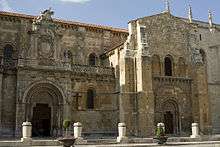Marquis of San Isidro

Marquis of San Isidro (Spanish: Marqués de San Isidro) was an important hereditary title in the Spanish nobility.[1] On 14 January 1730, the title Viscount of Benafarces inherited by Pablo de Rui-Gómez y Balmaseda in 1729, was elevated to the title Marquis of San Isidro by the king Philip V, in recognition of his contribution to the restoration of the Basilica of San Isidoro in Leon, Spain.[2] The title recalls the name of the very same ancient Roman temple.
The baroque palace of the Marquesses of San Isidro was, before a heavy fire in 1942, located at an emblematic spot where the Spanish troops first rebelled against Napoleon in León. Furthermore, there is also an avenue in the same city, named after the third Marquis of San Isidro, Santos Rui-Gómez de Prado, who perished in battle fighting for Spain's independence from the French in 1813.
The House of Ruigómez, of northern Spanish origin also had in its possession the titles of Viscount of Benafarces and Lord of Benafarces y Lobones.

As of 2014, the title is vacant, as there are no current holders of it.[3]
Viscounts of Benafarces (1729)
- Pablo de Rui-Gómez y Balmaseda, 1st Viscount of Benafarces (1729-1730)
Marquesses of San Isidro (1730)
- Pablo de Rui-Gómez y Balmaseda, 1st Marquis of San Isidro (1730–1742)
- Juan de Rui-Gómez y Bustamante, 2nd Marquis of San Isidro (1742-1787)
- Santos Rui-Gómez y de Prado, 3rd Marquis of San Isidro (1787-1813)
- Francisco de Paula Rui-Gómez y de Prado, 4th Marquis of San Isidro (1813-1847)
- Francisco Manuel Rui-Gómez y Dañobeitia, 5th Marquis of San Isidro (1847-1885)
| Wikimedia Commons has media related to Marquis of San Isidro. |
References
- ↑ http://cosinasdeleon.com/calle-marqueses-de-san-isidro/
- ↑ http://digibug.ugr.es/bitstream/10481/22659/1/ANDÚJAR%20CASTILLO,%20Francisco%20y%20%20FELICES%20DE%20LA%20FUENTE,%20Mª%20del%20MAR.%20Nobleza%20y%20venalidad.%20El%20mercado%20eclsiástico%20de%20venta%20de%20t%C3%ADtulos%20nobiliarios%20en%20el%20siglo%20XVIII.pdf
- ↑ http://www.heraldaria.com/titulos_nobiliarios.php?menus=&id=3664